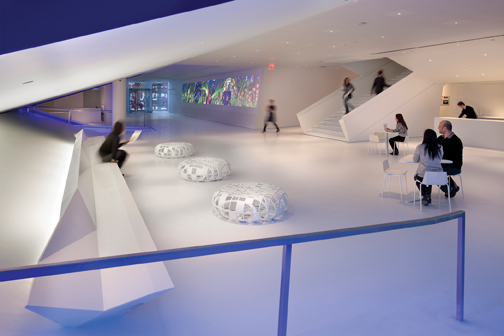The expansion and renovation of the Museum of the Moving Image in the Astoria section of Queens, N.Y., involved a complete redesign of its first floor and the construction of a three-story 47,000-sf addition. The extra square footage doubled the size of the museum, which is dedicated to the art, industry, and innovation of screen culture in all forms—from 19th-century optical toys to modern Web content. The $67 million project included a redesigned entrance and new lobby with a 50-foot-long video wall, a café, new gallery space, a 267-seat theater, a 68-seat film and digital media theater, and the Ann R. and Andrew H. Tisch Education Center, which is designed to handle 60,000 visiting school students annually. Outside, a new 10,370-sf courtyard will host fair-weather screening events. The Building Team included Lesser Architecture, F.J. Sciame Construction Co. (CM), Ambrosino, DePinto & Schneider (MEP), Anastos Engineering (structural), and Levien & Co. (owner’s rep).
Related Stories
| May 25, 2011
Low Impact Development: Managing Stormwater Runoff
Earn 1.0 AIA/CES HSW/SD learning units by studying this article and successfully passing the online exam.
| May 25, 2011
Register today for BD+C’s June 8th webinar on restoration and reconstruction projects
Based on new and award-winning building projects, this webinar presents our “expert faculty” to examine the key issues affecting project owners, designers and contractors in case studies ranging from gut renovations and adaptive reuses to restorations and retrofits.
| May 25, 2011
Hotel offers water beds on a grand scale
A semi-submerged resort hotel is the newest project from Giancarlo Zema, a Rome-based architect known for his organic maritime designs. The hotel spans one kilometer and has both land and sea portions.
| May 25, 2011
Smithsonian building $45 million green lab
Thanks to a $45 million federal appropriation to the Smithsonian Institution, the Smithsonian Environmental Research Center in Edgewater, Md., has broken ground on what is expected to be one of the most energy-efficient laboratories in the country. The 69,000-sf lab is targeting LEED Gold and is expected to use 37% less energy and emit 37% less carbon dioxide than a similar building.















